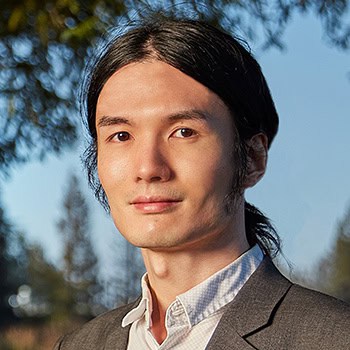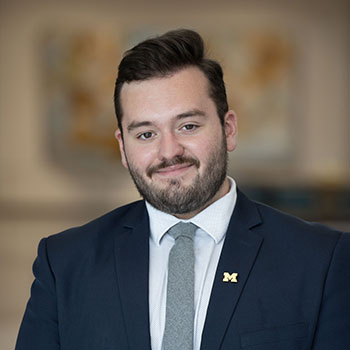
Welcoming Jiaqi Li to U-M CEE
Li hopes to foster mentorship and innovation while helping students to find the path within the engineering field that is right for them.

Li hopes to foster mentorship and innovation while helping students to find the path within the engineering field that is right for them.
Incoming Assistant Professor Jiaqi Li comes to the University of Michigan from his position as a Research Scientist at the Lawrence Livermore National Laboratory (LLNL). Before joining LLNL, he was a postdoctoral scholar in the Department of Civil and Environmental Engineering both at UC Berkeley, studying the chemistry of low-carbon cement, and at the Chemical Sciences Division at the Lawrence Berkeley National Laboratory, studying microalgae biomineralization.

Li’s research centers around energy conversion and chemistry in industrial byproducts and how renewable energy converts massive byproducts into value-added products for climate change mitigation, clean fuels and infrastructure materials. His eventual goal is to create and develop cutting-edge materials and systems for sustainable and scalable geochemical energy cycles that help reach net zero emissions and a circular carbon economy.
“I hope to integrate the development of materials or upcycling with renewable energy generation,” said Li. “Previously, these infrastructure materials heavily relied on the use of byproducts from conventional industries, which are carbon-emission intensive. Now, due to the energy transition, we have fewer materials available. We have to integrate the emerging energy industries to utilize these resources and create infrastructure materials for our community and for our infrastructure.”
While at Michigan, Li plans on continuing his research, possibly taking an interdisciplinary approach by collaborating with other departments and faculty members.
“Because my research interest is so broad, I would love to collaborate with other faculty members in the department — in geotech, in environmental engineering, in structural engineering and possibly transportation as well,” said Li. “And, because many of these research areas are interdisciplinary, I would like to collaborate with faculty in other departments as well. Architecture, bioengineering, chemistry — we all could create some synergy between us.”
In terms of his research and potential future projects while at CEE, Li is most excited to pursue the application of renewable energy to infrastructure systems. He hopes that his work will benefit not only the greater field of civil and environmental engineering but the local Ann Arbor community as well.
“I’m very interested in the integration between infrastructure materials and renewable energy — building a new infrastructure system that includes both renewable energy use and generation and the production of low carbon construction materials,” said Li. “For the local community, the upcycling of waste can lower health risks and other negative impacts on the landscape. We can then reuse these processed wastes to build within the community.”
By opening up opportunities for students to engage with and participate in his research, Li hopes to foster mentorship and innovation while helping students to find the path within the engineering field that is right for them.
“I highly encourage both undergraduate and graduate students to participate in research,” said Li. “It provides a useful opportunity to gain experience in different research areas so that the student can understand or decide their goal and what motivates them to pursue a career in civil and environmental engineering.”
As the civil and environmental engineering field constantly grows and changes, Li believes engaging with research as a student is more important now than ever.
“The boundaries of civil and environmental engineering are always expanding,” said Li. “I believe that the next generation of CEE professionals should have an opportunity to learn new principles and gain experience in new areas.”
When it comes to pedagogy and his classroom environment, Li values multidisciplinary studies and student engagement just as does in his research. At CEE, he will prioritize hands-on classwork experience and applying course materials to real-life scenarios.
“It’s important to have lab sessions so that students can get more familiar with the teaching materials and have hands-on experience that will foster their interest in both the course materials and in pursuing a career in civil and environmental engineering,” Li said.
“It’s also good to have more examples or case studies for the students apart from basic teaching materials and coursework,” Li continued. “Students have more engagement with these activities and it makes learning the course materials much more interesting.” Li plans to tie in campus culture to his lessons, proposing an activity where students calculate the carbon footprint of concrete use in the Big House.
Creating engaging and educational experiences for students is central to Li’s overall goals as a future U-M CEE faculty member.
“One of my long-term goals is to develop new and interesting courses in order to convince more students to pursue a career in civil and environmental engineering,” said Li.
Collaboration is also central to Li’s hopes for his future at CEE.
“I’m excited to explore new ideas through working together with other faculty both inside and outside of the department so that we can continue to broaden the horizons of civil and environmental engineering. Finally, I hope to develop a new research program on new infrastructure materials, construction automation, and renewable energy, to help us to make our world a better place.”
Learn more about Jiaqi Li in our introductory podcast episode.

Marketing Communications Specialist
Department of Civil and Environmental Engineering